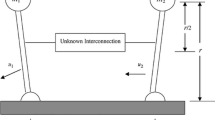Abstract
This paper investigates the problem of coordination control for a group of trains by neural adaptive approach. The communication structure among trains is a bidirectional one, i.e., necessary information of neighboring trains is used in the control design for a train. Two control schemes are developed, with the first one requiring the information of position, speed, and acceleration of neighboring trains, while the second requiring the information of position of neighboring trains only by virtue of high-order sliding mode observer technique. Based on the universal approximation capacity of radial basis function neural networks, there are no requirements of the precise parameters describing operational resistance and other kinds of extra resistances in the controller design, which are reconstructed by radial basis function neural networks online. The stability of single train and multiple trains are guaranteed by Lyapunov stability theorem. Numerical simulations are presented to demonstrate the effectiveness and performance of the proposed controllers.




Similar content being viewed by others
References
Chong KT, Roh DH et al (2001) A Lyapunov function approach to longitudinal control of vehicles in a platoon. IEEE Trans Veh Technol 50(1):116–124
Gao S, Dong H, Chen Y, Ning B, Chen G, Yang X (2013) Approximation-based robust adaptive automatic train control: an approach for actuator saturation. IEEE Trans Intell Transp Syst 14(4):1733–1742
Gao S, Dong H, Ning B (2014) Characteristic model-based all-coefficient adaptive control for automatic train control systems. Sci China Inf Sci 57(9):1–12
Gao S, Dong H, Ning B, Chen L (2015) Neural adaptive control for uncertain nonlinear system with input saturation: state transformation based output feedback. Neurocomputing 159:117–125
Haykin S (2010) Neural networks: a comprehensive foundation, 1994. Mc Millan, New Jersey
Ioannou PA, Sun J (2012) Robust adaptive control. Courier Dover Publications, New York
Jain LC, Seera M, Lim CP, Balasubramaniam P (2014) A review of online learning in supervised neural networks. Neural Comput Appl 25(3–4):491–509
Khalil HK (2002) Nonlinear systems, 3rd edn. Prentice Hall, Upper Saddle River
Khalil HK, Grizzle J (2002) Nonlinear systems, vol 3. Prentice hall, Upper Saddle River
Levant A (1998) Robust exact differentiation via sliding mode technique. Automatica 34(3):379–384
Levant A (2003) Higher-order sliding modes, differentiation and output-feedback control. Int J Control 76(9–10):924–941
Levant A, Livne M (2015) Uncertain disturbances attenuation by homogeneous multi-input multi-output sliding mode control and its discretisation. IET Control Theory Appl 9(4):515–525
Li S, Sun H, Yang J, Yu X (2015) Continuous finite-time output regulation for disturbed systems under mismatching condition. IEEE Trans Autom Control 60(1):277–282
Peters AA, Middleton RH, Mason O (2014) Leader tracking in homogeneous vehicle platoons with broadcast delays. Automatica 50(1):64–74
Seiler P, Pant A, Hedrick K (2004) Disturbance propagation in vehicle strings. IEEE Trans Autom Control 49(10):1835–1842
Sheikholeslam S, Desoer CA (1993) Longitudinal control of a platoon of vehicles with no communication of lead vehicle information: a system level study. IEEE Trans Veh Technol 42(4):546–554
Su S, Tang T, Chen L, Liu B (2014) Energy-efficient train control in urban rail transit systems. Proceedings of the Institution of Mechanical Engineers, Part F: Journal of Rail and Rapid Transit, p 0954409713515648
Su S, Tang T, Li X, Gao Z (2014) Optimization of multitrain operations in a subway system. IEEE Trans Intell Transp Syst 15(2):673–684
Swaroop D, Hedrick J (1996) String stability of interconnected systems. IEEE Trans Autom Control 41(3):349–357
Swaroop D, Hedrick J, Chien C, Ioannou P (1994) A comparison of spacing and headway control laws for automatically controlled vehicles1. Veh Syst Dyn 23(1):597–625
Wang H, Yu F, Zhu L, Tang T, Ning B (2014) Finite-state markov modeling for wireless channels in tunnel communication-based train control systems. IEEE Trans Intell Transp Syst 15(3):1083–1090
Wang LY, Syed A, Yin GG, Pandya A, Zhang H (2014) Control of vehicle platoons for highway safety and efficient utility: consensus with communications and vehicle dynamics. J Syst Sci Complex 27(4):605–631
Xu L, Wang LY, Yin G, Zhang H (2014) Communication information structures and contents for enhanced safety of highway vehicle platoons. IEEE Trans Veh Technol 63(9):4206–4220
Xun J, Ning B, Li Kp, Zhang Wb (2013) The impact of end-to-end communication delay on railway traffic flow using cellular automata model. Transp Res C Emerg Technol 35:127–140
Yin J, Chen D, Li L (2014) Intelligent train operation algorithms for subway by expert system and reinforcement learning. IEEE Trans Intell Transp Syst 15(6):2561–2571
Zhang L, Zhuan X (2014) Optimal operation of heavy-haul trains equipped with electronically controlled pneumatic brake systems using model predictive control methodology. IEEE Trans Control Syst Technol 22(1):13–22
Zhao N, Roberts C, Hillmansen S (2014) The application of an enhanced brute force algorithm to minimise energy costs and train delays for differing railway train control systems. Proc Inst Mech Eng F J Rail Rapid Transit 228(2):158–168
Zhu L, Yu F, Ning B, Tang T (2014) Design and performance enhancements in communication-based train control systems with coordinated multipoint transmission and reception. IEEE Trans Intell Transp Syst 15(3):1258–1272
Acknowledgments
This work is supported jointly by the Fundamental Research Funds for Central Universities (No. 2015JBZ007), National Natural Science Foundation of China (No. 61233001, No. 61322307), the State Key Laboratory of Rail Traffic Control and Safety, Beijing Jiaotong University Research Program (No. RCS2014ZT18).
Author information
Authors and Affiliations
Corresponding author
Rights and permissions
About this article
Cite this article
Gao, S., Dong, H., Ning, B. et al. Neural adaptive coordination control of multiple trains under bidirectional communication topology. Neural Comput & Applic 27, 2497–2507 (2016). https://doi.org/10.1007/s00521-015-2020-y
Received:
Accepted:
Published:
Issue Date:
DOI: https://doi.org/10.1007/s00521-015-2020-y




